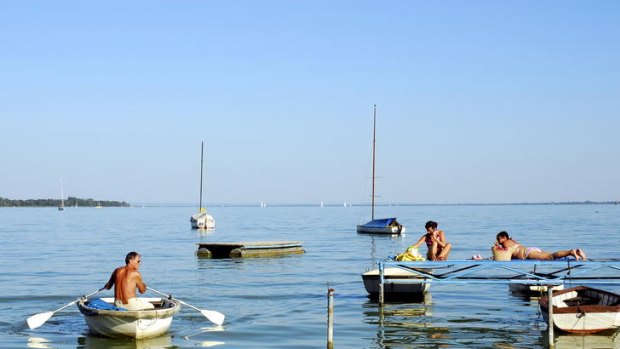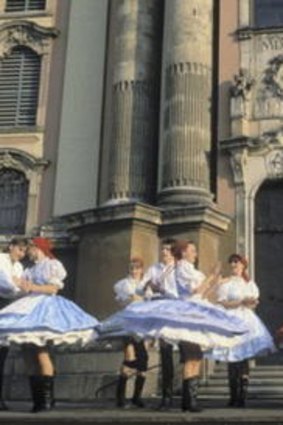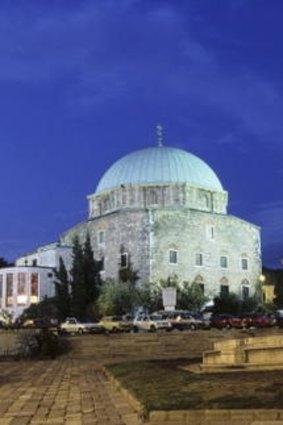
Magyar magic ... Lake Balaton at Keszthely.Credit: Getty Images
Beyond Budapest, second-time visitor Steve McKenna discovers a resort-studded lake, Ottoman relics, barrels of wine and bundles of hospitality
FOR my first trip to Hungary, I did as most foreigners do and stuck to Budapest. The capital's opulent architecture, Vienna-esque coffee houses, luxuriant steam baths and, compared with the euro zone, its super-reasonable prices made an enchanting impression, but I left the country feeling I'd barely gotten under its skin.
It would be different second time around, inspired, in part, by Hungarians I'd met in Britain, Spain and Germany.

Dancers in traditional dress at Eger.
Like many residents of the old Soviet bloc, they'd emigrated west, for work and better wages, but nostalgia was palpable when they spoke of their homeland. I decided to check out some of the places they pined for.
Lake Balaton
The young woman from Siofok's tourist information office delivers the directions in a hotchpotch of Hungarian, German and English - with lots of hand movements. It seems I have to go straight ahead, take a right, veer left, go a bit further and voila, I'll be at my hotel. I'm about to go walkies when a passer-by calls out, in accented but excellent English. "Wait, wait," she says. "Did you understand all that?"

Pecs's Mosque church.Credit: Getty Images
Within 30 seconds, I'm surrounded by five motherly Hungarians, ushering me towards my hotel, with waves and smiles and directions (in English). "Look at all these women wishing to help you," says the first passer-by. "We are very friendly in Hungary. We hope you like it here." Struck by their kindness - they're definitely not angling for a tip - it's a good start to my second Hungarian trip.
Siofok is a two-hour train ride from Budapest. Dubbed Hungary's summer capital, it's one of the myriad resorts strung along Lake Balaton, which is known as Hungary's sea and is said to be Europe's largest freshwater lake outside Scandinavia (it's 77 kilometres long and 14 kilometres wide).
Settled in the past by numerous tribes, including the Romans and the Magyars (the first Hungarians), Balaton is famed for its mineral-rich thermal springs and became a popular vacationing spot for the Hungarian bourgeois in the 18th and 19th centuries, before assuming even greater national importance following World War I.
The country had been part of the Habsburg (Austro-Hungarian) Empire, which collapsed after being on the conflict's losing side, and the 1920 Treaty of Trianon stripped Hungary of two-thirds of its territory, cutting it off from the Adriatic coast and leaving it landlocked.
In the 1960s and '70s, despite being part of the Soviet Union, a more liberal form of communism - dubbed "goulash" communism, after the soupy-stewy national dish - flourished in Hungary and everyday Hungarians, especially trade union members, flocked to Balaton, where they'd holiday alongside Germans from both sides of the Berlin Wall (relatives cut off from Germany's east-west divide would enjoy annual reunions here).
Siofok, on the lake's south-eastern side, has been tagged Hungary's Ibiza and although there are parties until dawn on the waterfront and a row of bars and clubs ranging from stylish to downright tacky, this is no San Antonio.
By day it's more of a laid-back family resort, with water-based fun and games - including swimming, sailing, fishing and windsurfing - a cluster of spas and wellness centres and pleasure cruises to be had on the bluey-emerald lake.
I take a ferry to Tihany, set on a wooded peninsula and nature reserve on Balaton's northern banks.
Amid much on-board chatter in German and Hungarian, my ears detect a few English voices. One belongs to Keith, a fiftysomething Londoner, who, with his wife, owns a home near Siofok.
"Right on the water, two-bedroom cottage, only cost £35,000 [$54,000]," he says. "More foreigners [and not just Germans] are buying properties here. Can't blame 'em. The cost of living is much cheaper than back home and it's a lovely place. Winter can be bitterly cold [about minus 20 degrees] and the lake freezes over but it's a beautiful sight. Good for ice skating, too."
Before very long the twin-towered 18th-century hilltop church crowning Tihany comes into view. A pretty village with a sprinkling of eateries and souvenir stalls (ceramics, embroidery and folk craft are the specialities), it has shaded walking trails that make for a pleasant afternoon. As I stroll I see quite a few cyclists. Fitness freaks can complete the 200-kilometre Balaton trail - along designated biking paths and quiet roads circling the lake - in a day.
A more beguiling, and leisurely, option is to stagger it with stop-offs, including the vineyards in and around Badacsony (the Romans are credited with introducing viticulture here), the spa hub of Heviz and Keszthely, an historic market town home to Balaton's most ostentatious landmark: the 101-room Festetics Palace.
Visitors can peruse the lavishly decorated interior of this baroque masterpiece, a former residence of a prominent aristocratic Hungarian family, and, in summer, savour evening bandstand concerts in its neatly manicured gardens. Slightly more lowbrow but, to some, more amusing are Keszthely's quirky museums, which cover subjects such as erotica, torture, dolls, toys, marzipan, nostalgia and kitsch. They shoulder cafes and restaurants on pedestrianised Kossuth Lajos street.
After lazing on Keszthely's beach and enjoying one last dip in Balaton's moderately warm waters, I leave the lake behind for a weekend in Hungary's fifth largest city and, according to many, the country's most attractive outside Budapest.
Pecs
Edged by the wooded foothills of the Mecsek mountains and swathes of bucolic countryside, this lively university town - pronounced "Paitch" - is dotted around a largely traffic-free centre that was spruced up for its stint as 2010 European Capital of Culture.
Pecs's history dates back to Roman times, when it was known as Sopianae, and excavation work has uncovered the 4th-century chapels and tombs of Cella Septichora, richly decorated with early Christian frescoes.
Pecs's icon is the green-domed Mosque Church, which dominates the main fountain and statue-studded square. It's the most obvious relic of the Ottoman occupation, which saw the city - and most of the country - under Turkish rule from the mid-1500s to the late 1600s, before the Austrian Habsburgs took over. Now the parish church of the inner city, the building boasts distinctive Islamic arches, inscribed but faded verses of the Koran and a rooftop crescent (capped by a cross).
Pecs has a vibrant cultural scene, with open-air events, festivals and street music held regularly between March and September. Ballet and opera performances take place at Pecs's National Theatre, while there's half a dozen decent museums and galleries. I like the small yet impressive one showcasing the flamboyant works of Tivadar Kosztka Csontvary. Dubbed Hungary's van Gogh, this pharmacist-turned-artist hit his peak at the turn of the 20th century, with some epic, mind-bending paintings of Jerusalem and Byblos. He could count Pablo Picasso among his fans and, apparently, the Spaniard once chided Belorussian-French artist Marc Chagall that he couldn't produce a painting "half as good as one of Csontvary's".
Although Pecs officially has a mild sub-Mediterranean climate, it's baking hot on my visit (August) and
I seek frequent refuge under the umbrellas of its alfresco cafes and ice-cream parlours. Sleek, cosmopolitan dining choices sidle next to smoky, down-to-earth joints, where you can have plates of schnitzels and paprika-infused pork stew and gnocchi-like dumplings for less than 750 forints ($3.50).
My sweet tooth constantly drew me to Oazis, a popular Middle Eastern kebab-shop confectionery on the main drag. Its slices of sticky baklava are divine.
Kiskassa
Food is one of the highlights of my stay at Ecohun, a humble guest house on a small organic farm in the tiny village of Kiskassa, 17 kilometres from Pecs. Run by affable Anglo-Hungarian couple Alan and Eva Durant, guests stay in renovated peasant buildings (with antique furniture and mod-cons, including wi-fi), surrounded by fruit and vegetable patches and a gaggle of geese, goats and hens.
The Durants produce about 80 per cent of what they consume and Eva charges €3 ($4) a three-course meal - an absolute steal. A typical lunch is soup, followed by meatballs (or beef stew), potatoes and vegetables, then dessert of, say, apple strudel. In the evenings, there's a spread of eggs, salad, salami, ham, cheese and fresh bread. The apple juice, made on the premises, is thirst-quenchingly good.
Kiskassa has some nice countryside walks but it's an ideal place to kick back, relax and recharge, especially if you like reading. The Durants have a wonderful book collection - ranging from Hungarian history and cultural affairs to modern and ancient English-language gems. The hosts are great to chat to, too. Our topics of discussion include the vagaries of the Hungarian language (a non-Indo-European tongue, it's closer to Finnish than Slavic), how some Hungarians prefer communism to capitalism and the country's best tipples.
Hungary has about 20 wine-growing regions and Kiskassa is a short bus journey from the vineyards and cellars of one of them, Villany.
I resist the temptation because my next - and last - Hungarian stop is possibly the most seductively named viticultural spot on the planet.
Eger and the Valley of the Beautiful Women
Studded with vineyards and wine cellars, the Valley of the Beautiful Women (also known as Nice Woman Valley) sits on the green outskirts of Eger, a picturesque town in northern Hungary famed for its baroque architecture and 40-metre-high minaret. It's believed the beautiful women were goddesses of a prehistoric religion, similar to Venus (the goddess of love). Sacrifices were offered to them in a place that yields a variety of wines.
The local speciality is bull's blood. Legend has it that when Eger was under siege by the Turks in 1552, a general gave this full-bodied red wine to his demoralised soldiers. When the Ottomans saw the Hungarians' red-stained beards, rumours circulated that they were drinking bull's blood to stiffen their resolve.
The valley is calm, civilised and family-friendly today. Wineries, with cavernous cellars and front terraces, are fringed around a leafy park and people are sipping glasses of red, white and rose (dry, semi-dry, sweet), for 100 forints a pop. Come with plastic bottles and jerry cans, like the locals, and you can fill them up with your favourite tipple for a few hundred forints more.
As the sun begins to set, a band, dressed in traditional costume, begins playing violins and cellos. I listen for a while - and it's very pleasant - but I've been here all afternoon, tasting every type of wine (spending about $3). It's time I went.
I usually have a rule when tipsy: don't make rash decisions. I'll make an exception here, though. This won't be my last trip to wonderful, underrated Hungary.
Trip notes
Getting there
KLM has a fare from Sydney to Budapest via Kuala Lumpur and Amsterdam for $1814 return, klm.com.
Getting around
Hungary's major towns and cities are linked by a reasonably efficient rail service, with Budapest the main hub. See www.mav.hu for timetables. Buses fill the gaps where the trains don't go, volan.eu. Hungary's roads are decent and hiring a car would give you more freedom. The multinational hire chains are represented at Budapest's airport, bud.hu.
Staying there
Branches of Tourinform (tourinform.hu/english) can be found in most large towns and cities and can help arrange accommodation. In Kiskassa, Ecohun has bed and breakfast from €10 ($13) a person a night. ecohun.com.
Tip
If you can't find a Hungarian-English dictionary, consider a German-English one. While a lot of the younger generation speak English, the older ones are more able with Deutsch and some restaurant menus are in German instead of English.
Sign up for the Traveller Deals newsletter
Get exclusive travel deals delivered straight to your inbox. Sign up now.